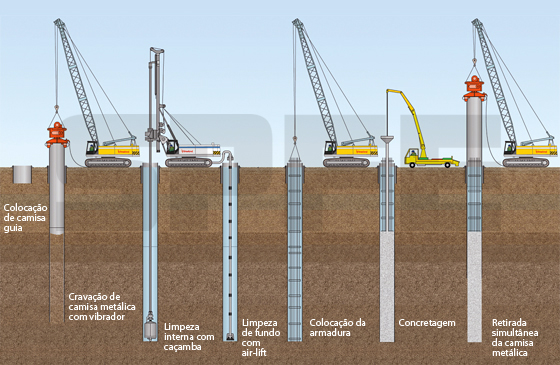
Piles without bentonite slurry or a polymer
For environmental reasons, the use of bentonite slurry to stabilise pile excavation walls has become somewhat questionable. Although the use of polymers has been largely developed, it might not be the solution for all situations, mainly due to the type and degree of the soil aggressiveness and the water contained in its pore spaces.
As a result, SPFE has developed piles for its project Bridge Over the Tejo River in Carregado, Portugal, that are fully encased and recovered without the use of bentonite slurry or a polymer.
Implementation Methodology
a) Drill and casing guide are positioned;
b) Spiking of the casing guide, using a high power vibrator to the designed depth. Depending on the length of the pile, casing may be spiked into various welded segments. Before welding each new element, internal cleansing is done using the drill while keeping the reinforcement full of water;
c) Upon reaching the project depth, 'dirty' water is replaced by clean water and the lower end is cleaned using the 'air-lift';
d) Reinforcement cage placed in modules, according to its length;
e) Underwater concreting, with simultaneous removal of the casing, which also occurs in segments.
Worthy of mention is that the methodology shown below may present a variation when the excavation is only partially reinforced with casing (for example, during an initial stage, where there is a thick layer of soft clay). In this case, the use of bentonite slurry or the polymer will be a requirement to stabilise the portion of the excavation with no casing.


 Large diameter Bored Pile
Large diameter Bored Pile Slurry Wall
Slurry Wall Diaphragm Pile
Diaphragm Pile CFA Pile
CFA Pile Root Pilles
Root Pilles Jet Grouting
Jet Grouting Environmental Geotechnics
Environmental Geotechnics Soil improvement
Soil improvement Cutter Soil Mixing
Cutter Soil Mixing Hydromill
Hydromill Tiebacks
Tiebacks Massive treatment
Massive treatment Static load tests
Static load tests Pt
Pt














